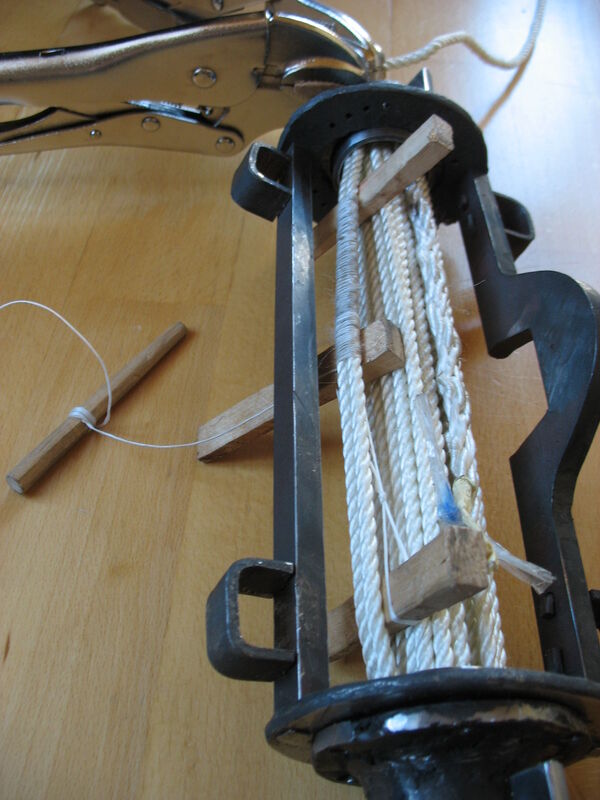Introduction[]
Lashing cords together is a useful technique for locking the end of the spring cord into some previous cord to prevent it from slipping.
Preparations[]
Before starting with the lashing, clip the spring cord particularly well, e.g. with two pairs of locking pliers. You do not want the spring cord to get loose just when you've just spent hours getting it inside the field-frame.
Lashing can be simplified with the following arrangement:
Here two wedges at the edges are used to separate the last two spring cords from the rest of the bundle. The center wedge has another purpose described below.
Lashing[]
Take a long piece of strong string. Sinew is probably the best choice as it shrinks when it dries. Dacron works, but tightening it too much may break it. Linen should work, with the caveats as with dacron. Dynema is probably the best available modern material as it is ridiculously strong and breaking it accidentally is unlikely.
Lay one end of the string parallel to the two cords you separated earlier. Then wrap the string around the two cords a few times until the string parallel to the cords is fixed in place. Ensure the parallel string is long enough to allow you to bind it to the other end of the string when the wrapping is finished.
Now start wrapping the string around the cords, tightening it as much as you can. It helps if you first wrap the string around a small round wooden dowel (see above), which you can then use as a handle to assist pullback and to save your hands. Once the string is tight, use the third wedge to lock it in place before continuing with the next round.
Once you've lashed the cords together sufficiently well, tie the ends of the string together. Then reattach the field-frame to the stretcher, pass the end of the spring cord through the axle in the winch, tighten the cord, lock the axle and remove the clip(s). Then slowly loosen tension using the winch to see if the cords slip between the wrappings. If not, you're good to go.
Technically speaking the last step is not necessary. However, it would be most annoying if your wrapping was insufficient and the spring cord got loose after hours spent setting up the torsion spring.
Note that you do not necessarily need lots of wrapping to keep the cords attached. For example, in a cheiroballistra torsion spring composed of 4mm nylon three-ply cord tuned to 320hz, making five passes was just enough to prevent cords from slipping. Of course more is required in practice, but an excessive amount is definitely not needed. I've used lashings that are 8-13cm long, just to be on the safe side.
